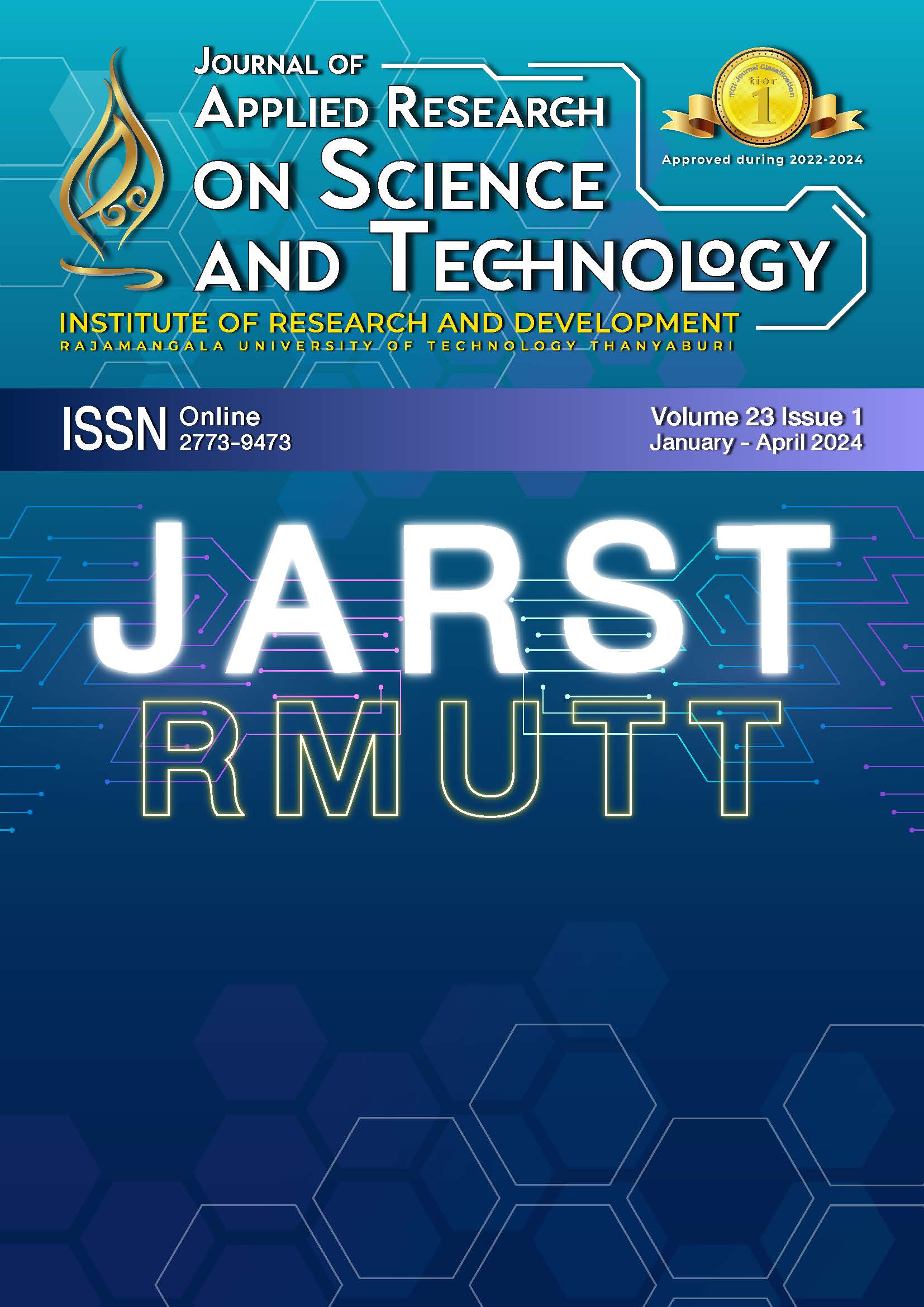Preparation of poly(methyl methacrylate)-zinc oxide hybrid nanoparticles via miniemulsion polymerization
Main Article Content
Abstract
The encapsulation of zinc oxide (ZnO) nanoparticles with poly(methyl methacrylate) in the presence of triethylene glycol dimethacrylate (TEGDMA) as a crosslinking agent was synthesized by the miniemulsion polymerization technique. The ZnO as a catalyze was varied from 1 wt% - 7 wt%. Several techniques were used to analyze the PMMA/TEGDMA/ZnO hybrid. The morphology and particle size distribution of the PMMA hybrid was observed using a field emission scanning electron microscope (FE-SEM). The diameter of the PMMA/TEGDMA/ZnO hybrid was in the range of 57 nm to 115 nm. The morphology of the PMMA/ZnO hybrids was sphere-shaped with a narrow particle size distribution and no agglomeration of the hybrids occurred. The encapsulation and crystalline structure of the PMMA ZnO hybrid were determined using a high-resolution transmission electron microscope (HR-TEM). The HR-TEM image demonstrated that the ZnO was encapsulated in the PMMA hybrid. In addition, the high magnification of the TEM image demonstrated the lattice spacing of ZnO and the diffraction mode image presented the crystalline structure of ZnO. Therefore, the photocatalytic properties of the PMMA/ZnO hybrid were examined via the degradation of methylene blue (MB) solution under dark and UV-A irradiation. It was found that the photocatalytic activities of the PMMA/ZnO hybrid increased when the ZnO content increased up to 7 wt%. The maximum MB degradation for PMMA/TEGDMA/ZnO 7 wt% and PMMA/ZnO 7 wt% were 80.1 % and 77.6 %, respectively. Thus, the photocatalytic efficiency of the PMMA/ZnO increased in the presence of TEGDMA as a crosslinking agent.
Article Details

This work is licensed under a Creative Commons Attribution-NonCommercial-NoDerivatives 4.0 International License.
References
John Ł, Ejfler J. A brief review on selected applications of hybrid materials based on functionalized cage-like silsesquioxanes. Polymers. 2023;15(6):1452.
Young G, Tallia F, Clark JN, Chellappan M, Gavalda-Diaz O, Alcocer EJ, et al. Hybrid materials with continuous mechanical property gradients that can be 3D printed. Mater Today Adv. 2023;17:100344.
Zhang M, Gao G, Li C-Q, Liu F-Q. Titania-coated polystyrene hybrid microballs prepared with miniemulsion polymerization. Langmuir. 2004;20(4):1420-4.
Katagiri K. Chapter 5 - Organic-Inorganic Hybrid Nanoarchitecture at Mesoscale. In: Ariga K, Aono M, editors. Supra-Materials Nanoarchitectonics: William Andrew Publishing; 2017. p. 117-33.
Jahanzad F, Karatas E, Saha B, Brooks BW. Hybrid polymer particles by miniemulsion polymerisation. Colloids Surf A: Physicochem Eng. 2007;302(1-3):424-9.
Metanawin S, Metanawin T. Fabrication of hybrid polystyrene-titanium dioxide with enhanced dye degradation and antimicrobial properties: investigation of the effect of triethylene glycol dimethacrylate on photocatalytic activity. Polym Int. 2022;71(7):777-89.
Metanawin S, Sornsuwit N, Metanawin T. Miniemulsion polymerization technique enhancement: the photocatalysis of commercial rutile-TiO2 hybrids with nano poly(methyl methacrylate). Polym-Plast Technol Mater. 2022;61(1):56-68.
Metanawin T, Panutumrong P, Metanawin S. Synthesis of polyurethane/TiO2 hybrid with high encapsulation efficiency using one-step miniemulsion polymerization for methylene blue degradation and its antibacterial applications. ChemistrySelect. 2023;8(11):e202204522.
Teo BM, Prescott SW, Ashokkumar M, Grieser F. Ultrasound initiated miniemulsion polymerization of methacrylate monomers. Ultrason Sonochem. 2008;15(1):89-94.
Livage J. Sol-gel synthesis of hybrid materials. Bull Mater Sci. 1999;22(3):201-5.
Landfester K. Synthesis of colloidal particles in miniemulsions. Annu Rev Mater Res. 2006;36(1):231-79.
Rao JP, Geckeler KE. Polymer nanoparticles: Preparation techniques and size-control parameters. Prog Polym Sci. 2011;36(7):887-913.
Antonietti M, Landfester K. Polyreactions in miniemulsions. Prog Polym Sci. 2002;27(4):689-757.
Zhou J, Cui Y, Yao H, Ma J, Ren H. Nanocapsules containing binary phase change material obtained via miniemulsion polymerization with reactive emulsifier: Synthesis, characterization, and application in fabric finishing. Polym Eng Sci. 2019;59(s2):E42-51.
Khan MM, Adil SF, Al-Mayouf A. Metal oxides as photocatalysts. J Saudi Chem Soc. 2015;19(5):462-4.
Disha KM. Metal oxide nanomaterials for photocatalytic degradation of antibiotics. Mater Today: Proc. 2023.
Yemmireddy VK, Hung YC. Using Photocatalyst metal oxides as antimicrobial surface coatings to ensure food safety-opportunities and challenges. Compr Rev Food Sci F. 2017;16(4):617-31.
Lu PJ, Huang SC, Chen YP, Chiueh LC, Shih DYC. Analysis of titanium dioxide and zinc oxide nanoparticles in cosmetics. J Food Drug Anal. 2015;23(3):587-94.
Agarwal H, Venkat Kumar S, Rajeshkumar S. A review on green synthesis of zinc oxide nanoparticles - An eco-friendly approach. Resource-Efficient Technologies. 2017;3(4):406-13.
Zhou XQ, Hayat Z, Zhang DD, Li MY, Hu S, Wu Q, et al. Zinc Oxide Nanoparticles: Synthesis, Characterization, Modification, and Applications in Food and Agriculture. Processes. 2023;11(4):1193.
Fogaça LA, Feuser PE, Ricci-Júnior E, Hermes de Araújo PH, Sayer C, Costa C. ZnO and quercetin encapsulated nanoparticles for sun protection obtained by miniemulsion polymerization using alternative co-stabilizers. Mater Res Express. 2020;7(1):015096.
Al-Shannaq R, Farid M, Al-Muhtaseb S, Kurdi J. Emulsion stability and cross-linking of PMMA microcapsules containing phase change materials. Sol Energ Mat Sol C. 2015;132:311-8.
Liang K, Liu Q, Peng M. Monodisperse cross-linked polystyrene nanospheres by emulsifier-free miniemulsion polymerization. e-Polym. 2015;15(4):263-70.
Erdem B, Sudol ED, Dimonie VL, El-Aasser MS. Encapsulation of inorganic particles via miniemulsion polymerization. Macromol Symp. 2000;155(1):181-98.
Singh S, Arora N, Paul K, Kumar R, Kumar R. FTIR and rheological studies of PMMA-based nano-dispersed gel polymer electrolytes incorporated with LiBF4 and SiO2. Ionics. 2019;25(4):1495-503.
Ahangaran F, Navarchian AH. Towards the development of self-healing and antibacterial dental nanocomposites via incorporation of novel acrylic microcapsules. Dent Mater J. 2022;38(5):858-73.
Hodásová Ľ, Alemán C, del Valle LJ, Llanes L, Fargas G, Armelin E. 3D-Printed polymer-infiltrated ceramic network with biocompatible adhesive to potentiate dental implant applications. Mater. 2021;14(19):5513.
Nagaraju G, Udayabhanu, Shivaraj, Prashanth SA, Shastri M, Yathish KV, et al. Electrochemical heavy metal detection, photocatalytic, photoluminescence, biodiesel production and antibacterial activities of Ag–ZnO nanomaterial. Mater Res Bull. 2017;94:54-63.


